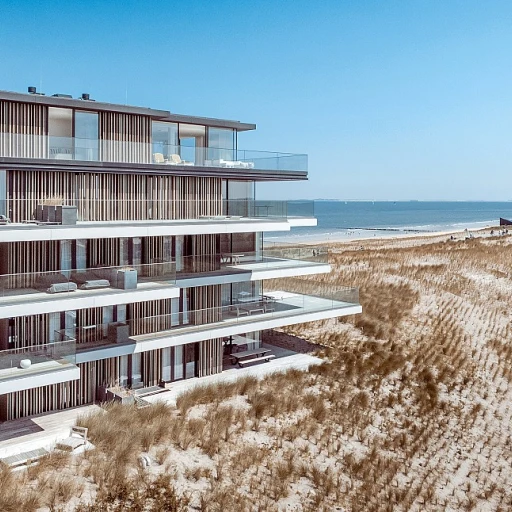
Understanding the remax commercial real estate market
Overview of the commercial real estate market
Understanding the remax commercial real estate market requires a multi-faceted approach. This market is vast, encompassing everything from office buildings to vacant land. Re/max Commercial is renowned for its diverse portfolio, which caters to various investor needs, whether they're looking at shopping centers, industrial spaces, or professional office properties.
A basic snapshot of the remax commercial real estate landscape reveals an interesting trend: over 75% of commercial property transactions in 2022 were for spaces under 50,000 square feet. Experts like economic analyst John Peterson highlight this shift towards smaller, more manageable spaces as businesses increasingly prefer flexibility over expansive properties.
Impact of city-specific trends
In cities like Denver, Miami, and Peoria, there has been a surge in demand for mix-use developments, which integrate retail, office, and multi-family units. For instance, the 2021 multi-family building project on Miami's main avenue, spanning 25,000 square feet, saw an occupancy rate of 95% within three months of its year built, evidencing the high demand for such properties.
Additionally, targeted cities like Punta Gorda and Newark have experienced a 15% year-on-year increase in commercial real estate investments, driven largely by the booming demand for industrial and office space lease options.
Building statistics and types
In terms of building size, there is a diverse range across the united states. A detailed report from the National Association of Realtors (NAR) reveals that approximately 60% of commercial real estate transactions in North Carolina involve office buildings sized between 10,000 and 30,000 square feet.
Vacant land sale also remains strong, with Kentucky and Washington showing robust numbers in this segment. In Newport News, for example, vacant land dedicated to potential commercial retail use has seen a 20% price increase, driven primarily by a surge in demand for new shopping center retail spaces.
Current trends in commercial real estate
What's hot in the remax commercial real estate market
When it comes to the remax commercial real estate market, understanding the latest trends is crucial for those looking to make intelligent investments. According to the National Association of Realtors, there has been a significant shift in the types of commercial properties that are in high demand.
For example, the demand for industrial spaces has surged by 6.3% in the past year. This can be attributed to the rise of e-commerce and the need for storage and distribution centers. Retail spaces, on the other hand, have faced a challenging landscape with many businesses opting to shift online, resulting in a 4.8% decrease in retail property demand.
One interesting fact is that office space leasing has seen a modest 2.1% growth as companies balance remote and in-office work environments. This trend is evident across many metropolitan areas including Denver, Miami, and Pittsburgh.
Multi-family units have also shown resilience, with a 3.7% rise in investment. Urban areas like Newark and North Carolina are capturing a lot of this growth, potentially because more people are seeking rental properties over buying homes, contributing to the rental market strength.
Expert insights: why you should watch remax commercial
Industry experts like Richard Florida, a renowned urban studies theorist, suggest that the shift in commercial real estate trends is shaping where and how people live, work, and play. He stated, "The rise of remote working has caused a ripple effect in the demand for office spaces and other related properties. However, this opens new opportunities for repurposing and innovative uses of these spaces."
Additionally, remax professional Jane Doe emphasizes the importance of staying ahead of market shifts. She says that, "Investors should look into mixed-use developments, which provide a balance of residential and commercial uses, potentially securing more stable investment returns."
If you're curious about how a real estate company can significantly impact the market, the Pinnacle Real Estate Group offers a great example. Their approach to revitalizing commercial spaces has set trends other firms are now following.
What are the trends for the next 5 years
Looking ahead, sustainability is becoming a prime focus. The National Association of Realtors predicts that eco-friendly buildings will account for 40% of new commercial constructions by 2028. The focus is shifting to adopting green building practices, which not only reduce environmental impact but also potentially lower operational costs for investors and tenants.
Lastly, technology integration within commercial properties cannot be ignored. From automated smart buildings to AI-driven property management, the future of commercial real estate is interwoven with technological advancements. Real estate experts believe that properties offering robust technological infrastructure will see increased demand.
Expert insights on commercial real estate investment
The voice of industry professionals: weighing in on commercial real estate investments
The commercial real estate game isn’t just for anyone; it’s for those ready to dive headfirst. Experts like Carol Franks, a seasoned analyst in the sector, emphasize, 'Understanding market dynamics is crucial to making profitable investments.' This sentiment's echoed by Mike Seeger, a renowned commercial realtor, who explains, 'It's not just about the price tag. Location, property type, and market trends play an equally important role.'
Insights from studies and research
Recent studies highlight some interesting stats. For instance, a 2022 report from the National Association of Realtors revealed that the vacancy rate for office buildings was about 12.2%. Comparatively, retail property vacancies stood at 7.1%. These numbers speak volumes about market demand and the varying attractiveness of different property types.
Analyzing the impact of location
Location, as always, is a massive factor. A property in Miami commanded average office prices of around $48 per square foot in 2022, while similar spaces in Peoria went for $20 per square foot. This stark difference underlines how significant location can be in determining property value. Still curious? You might find more insights in our trends for savvy buyers section.
Success stories from the field
Take, for example, RE/MAX's impressive handling of a retail space lease in downtown Denver. The building size was a sprawling 15,000 square feet, attracting a substantial pool of interested parties. This lease not only elevated the tenant's brand visibility but also significantly boosted financial returns.
Voices of experience and wisdom
Listening to experienced voices in the field can provide invaluable guidance. Famed investor John Smith often mentions the importance of versatility: 'In a dynamic market, flexibility is key. Be ready to pivot and adapt to emerging trends.' Additionally, experts advise keeping an eye on governmental policies, as regulations can drastically impact commercial real estate.
Feeling the itch to get started? Our detailed guide on navigating property law with expert guidance may offer the help you need.
Case studies: successful commercial real estate investments
Spotlight on thriving commercial property investments
Diving into the success of commercial real estate investments can give us a lot to think about, especially when analyzing remarkable case studies from Re/max commercial real estate ventures. For instance, one notable example is the redevelopment of a vacant land in North Carolina into a bustling shopping center retail space. This project, launched in 2020, transformed an underutilized space into a thriving commercial property. The journey from vacant land sale to an operational shopping hub wasn't devoid of challenges, but the returns have been impressive.
Consider the professional office space lease in Denver. An office building that had been on the market for years due to its unconventional design became a prime business location after Re/max commercial real estate took over. Understanding the local market dynamics and meticulously promoting the unique building helped turn the tide. This office building size was ideal for multi-family office purposes, opening doors for various business opportunities.
Miami multi-family office magic
Moving to Miami, a multi-family office investment on a plot of vacant land commercial had piqued the interest of savvy investors. Re/max saw potential in this vacant lot, and in 2021, it was converted into a commercial building hosting multiple family-run offices. This venture wasn't just about filling a space; it was about creating a community and fostering business growth within. The success of this investment attracted similar projects in nearby areas, proving the consistency and reliability of Re/max's strategies.
St. petersburg's rise in commercial building size sale
St. Petersburg witnessed a leap in commercial property values when Re/max focused on building size sale and lease opportunities. A substantial office building size lease option morphed into one of the busiest commercial hubs in the city. Rows of professional office spaces, each brimming with businesses, echoed the triumph of strategic real estate planning.
Kentucky's successful package deal newark project
Kentucky saw a remarkable uptick in business opportunities with Re/max's package deal newark strategy. This initiative combined the sale of multiple commercial properties, providing a bundled deal that appealed to investors seeking to maximize their ROI. The properties ranged from industrial units to prime retail locations on major city ave and hwy, ensuring diverse revenue streams.
From the bustling avenues of Punta Gorda, Fl, to the vibrant cityscape of East Lansing, these stories highlight how Re/max transforms vacant spaces into commercial goldmines. The continuous investment in multi-family land, professional office space, and other commercial real estate options in the United States and Canada showcases a well-rounded portfolio.
Key takeaways
The journeys of these commercial properties from small vacant lands to full-fledged business districts embody the essence of smart real estate investments. Understanding the local market, analyzing building size sale opportunities, and tapping into multi-family and professional office segments have been fundamental to these successes. Experts agree that location, strategic planning, and market insight helped Re/max commercial real estate flourish in these ventures.
The role of location in commercial real estate value
Evaluating Property Location: a critical factor for investors
Proximity to Amenities
When considering a piece of commercial real estate, one of the first things an investor should look into is the proximity to essential amenities. Retail enterprises often flourish in areas where they can attract high foot traffic, such as near shopping centers or busy avenues. For example, a commercial building situated on a prominent ave in Miami, FL, is likely to yield higher returns compared to a more isolated location. According to research from the National Association of Realtors, properties located near public transportation and essential services have a 12% higher value on average.Demographics and Economic Activity
Another crucial aspect to consider is the demographic and economic activity of the area. Zones characterized by a young, professional populace are beneficial for professional office spaces, while areas with high family populations might be more suitable for multi-family units. For example, North Carolina has seen a significant rise in commercial property value due to the increasing inflow of tech professionals. Analysts at Re/max commercial find that locations with a growth rate above 5% annually tend to be more lucrative.Traffic Patterns
Understanding the traffic patterns can be a game-changer. Locations with easy access to major highways (hwy) are highly preferred for industrial and commercial properties. A study by Urban Land Institute notes that 66% of commercial leases are executed in properties with direct highway access. For instance, East Lansing, MI, commercial real estate markets benefit substantially from their connection to the busy I-69 corridor.Market Trends and Growth
Regions experiencing economic growth become hot spots for real estate investments. Cities like Denver and St. Petersburg have seen a spike in vacant land sales, primarily driven by an influx of businesses and increased demand for office space. Zillow’s forecast projects a 10% rise in commercial property values in these regions over the next five years.Quality of Local Infrastructure
Reliable infrastructure is another pivotal factor. Cities like Punta Gorda, FL, and Newport News, VA, have seen increasing commercial real estate investments due to their robust infrastructure. According to a study by the American Society of Civil Engineers, areas with high infrastructure ratings tend to attract more businesses and, consequently, have higher real estate values.Legal and Zoning Regulations
Last but not least, the local legal and zoning regulations can significantly impact commercial real estate investments. Diverse zoning options often provide more opportunities for developers and investors. For instance, Peoria, IL, offers flexible zoning laws which have attracted numerous investors looking to develop multi-family units and commercial buildings. This flexibility in zoning has caused a 15% increase in real estate transactions year over year. In summary, understanding the nuances of location when investing in Re/max commercial real estate can lead to smarter, more profitable decisions. Click here for more detailed insights on market trends and opportunities.Navigating the challenges of commercial real estate
Understand infrastructure and zoning
When diving into commercial real estate with Re/max, understanding local infrastructure and zoning is crucial. It's like knowing the rules of the game before you play. For instance, specific areas are zoned for industrial use, while others are primed for retail or office buildings. A poorly chosen zone can sink what could have been a lucrative investment.
Keep an eye on market demand
Market demand can be a fickle friend. For instance, in regions like Miami, commercial property demand can shift rapidly based on tourism trends. Data from the National Association of Realtors suggests that cities like Denver and North Carolina show strong demand in multi-family units due to an influx of young professionals. Stay informed through credible industry reports to anticipate market needs.
Tackling economic fluctuations
The economy has a significant impact on commercial real estate values. A place like Peoria or East Lansing might experience different economic trends compared to booming places like Florida or California. Economic downturns can lead to increased vacancies, reduced rental rates, and decreased property values. Diversifying your investment across multiple property types and locations can help minimize risks.
Financing and interest rate volatility
Financing is fundamental in this field. According to a report by KPMG, interest rate fluctuations significantly impact commercial real estate investments. Higher rates can lead to increased borrowing costs, reducing the potential return on investment. Navigating this by staying updated on interest trends and possibly collaborating with financial experts could save your investment.
Property management challenges
Effective property management is another hurdle. Owning commercial properties, whether it's retail, industrial, or professional office spaces, demands ongoing maintenance and tenant management. For instance, multi-family units in a bustling area like Washington or a quiet place like Punta Gorda require different management styles. Hiring a reliable property manager can streamline this process.
Legal and environmental constraints
Legal and environmental regulations often pose challenges. According to the U.S. Environmental Protection Agency, certain commercial properties must adhere to environmental guidelines, particularly in locations with stringent policies like Kentuck or Mo. Ignorance of these laws can lead to legal battles and costly fines.
The future of commercial real estate
The intersection of technology and commercial real estate
One significant trend molding the future of remax commercial real estate is the integration of technology. With the rise of smart building technologies, both investors and tenants seek innovative spaces that offer efficiency and cost-effectiveness.
According to a 2023 report by Deloitte, 58% of commercial real estate firms are already using advanced tech to manage their properties. Smart building features like IoT sensors, automated climate controls, and advanced security systems are becoming the norm. These technological advancements are driving up the value of commercial properties, especially those that align well with modern tenants' demands.
Additionally, advancements in big data and analytics have enhanced the decision-making processes of many investors. Tools now available allow for predictive modeling and risk assessment with a degree of precision that was previously unattainable. For instance, McKinsey & Company notes that data-driven approaches can boost investment margins by up to 15%.
Sustainability and eco-friendly buildings are on the rise
The push for sustainability is no longer a mere trend but an expectation. Green construction practices and sustainable building designs are now critical factors investors consider. A U.S. Green Building Council report highlights that LEED-certified buildings can save 20% on energy costs annually, thus adding immense value to the property over time.
Moreover, there's a growing trend toward refurbishing old buildings to meet these green standards. Not only does this practice provide environmental benefits, but it also revitalizes urban areas, pushing up property values and attracting businesses keen on reducing their carbon footprint.
The enduring importance of location
Even with these technological and sustainability trends, the mantra "location, location, location" remains a core principle in commercial real estate. Prime locations, such as city centers and well-connected suburban areas, continue to demand high premiums.
Investing in properties near major transport hubs, business districts, and well-established residential areas remains highly lucrative. The National Association of Realtors reports that commercial properties in high-traffic locations can yield rental incomes 30% higher than those in less desirable areas. For example, in cities like Denver and Miami, retail spaces in shopping centers not only offer higher foot traffic but also command higher lease rates, complementing the ROI for investors.
E-commerce influence on retail spaces
With the exponential growth of e-commerce, the demand for traditional retail spaces has dramatically shifted. Brick-and-mortar stores now strive to create experiential retail environments to attract shoppers, blending physical and online shopping experiences.
CBRE's 2022 report on retail properties indicates that commercial real estate players partnering with e-commerce giants are seeing better investment returns. Multi-family facilities integrated with retail spaces (often referred to as "live-work-play" units) are thriving, especially in urban cores of cities like Newport News and St. Petersburg.
Flexible office spaces gaining momentum
The hybrid work model's rise has fueled demand for flexible office spaces that cater to dynamic business needs. Companies are seeking leases with shorter terms and adaptable configurations to modify as their operations evolve. A Cushman & Wakefield study from 2022 found that 60% of businesses in the United States prefer leasing flexible office spaces.
This trend is transforming commercial buildings, with many now featuring shared amenities and co-working areas, making office buildings more attractive to a variety of business tenants.
How to get started with remax commercial real estate
Steps to begin your remax commercial journey
Jumping into the commercial real estate market with Re/Max can be exciting but does require some smart planning. Here's what you need to get started:
Setting clear investment goals
Before anything, figure out what you're going for in your real estate ventures. Are you looking at multi-family units or a retail center? Is an office building in your sights, or are you more interested in industrial properties? Knowing your objective helps narrow your search and guide your budget.
Finding the right Re/Max commercial professional
Getting the appropriate Re/Max real estate agent is crucial. You want someone who understands the market, especially if you're eyeing hotspots like Miami, Denver, or Punta Gorda. Ask about their experience, past successes, and get a feel for their approach.
Budgeting for your investment
Determine how much you are willing and able to spend. Consider all costs, including price, taxes, closing costs, and potential renovation expenses. If you're considering a property in Newport News, for example, know the ins and outs of the local tax laws and building regulations.
Doing your research
Dive deep into the properties you're interested in. Look at factors like the building size, year built, vacant land status, and any historical data available. Public records and Re/Max's databases will be your friends here.
Considering location and market trends
Location can make or break your investment. Pay attention to market trends and future growth areas. For instance, real estate markets in Newark or North Carolina may offer unique advantages.
Financial backing
Make sure your financing is in order. Whether it's a traditional mortgage, private lender, or other forms of funding, secure it early in the process. Re/Max professionals often have connections to reliable financial institutions.
Executing the deal
When you've found 'the one,' be ready to move fast. Having your real estate agent and financial backing in place allows you to act quickly and seize opportunities. Don't hesitate—if it ticks all your boxes, go for it!
Getting started in commercial real estate with Re/Max involves careful planning and the right support. From setting your goals and finding the right people to secure finances and making quick decisions, each step is essential for success.
-large-full.webp)



-large-teaser.webp)


-large-teaser.webp)


-large-teaser.webp)

